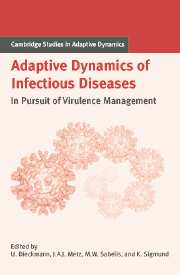Book contents
- Frontmatter
- Contents
- Contributing Authors
- List of Boxes
- Notational Standards
- 1 Introduction
- A Setting the Stage
- B Host Population Structure
- C Within-Host Interactions
- D Pathogen–Host Coevolution
- Introduction to Part D
- 13 Coevolution of Virus and Host Cell-death Signals
- 14 Biogeographical Perspectives on Arms Races
- 15 Major Histocompatibility Complex: Polymorphism from Coevolution
- 16 Virulence Management and Disease Resistance in Diploid Hosts
- 17 Coevolution in Gene-for-gene Systems
- 18 Implications of Sexual Selection for Virulence Management
- 19 Molecular Phylogenies and Virulence Evolution
- E Multilevel Selection
- F Vaccines and Drugs
- G Perspectives for Virulence Management
- References
- Index
- International Institute for Applied Systems Analysis
15 - Major Histocompatibility Complex: Polymorphism from Coevolution
Published online by Cambridge University Press: 15 January 2010
- Frontmatter
- Contents
- Contributing Authors
- List of Boxes
- Notational Standards
- 1 Introduction
- A Setting the Stage
- B Host Population Structure
- C Within-Host Interactions
- D Pathogen–Host Coevolution
- Introduction to Part D
- 13 Coevolution of Virus and Host Cell-death Signals
- 14 Biogeographical Perspectives on Arms Races
- 15 Major Histocompatibility Complex: Polymorphism from Coevolution
- 16 Virulence Management and Disease Resistance in Diploid Hosts
- 17 Coevolution in Gene-for-gene Systems
- 18 Implications of Sexual Selection for Virulence Management
- 19 Molecular Phylogenies and Virulence Evolution
- E Multilevel Selection
- F Vaccines and Drugs
- G Perspectives for Virulence Management
- References
- Index
- International Institute for Applied Systems Analysis
Summary
Introduction
There are many examples of pathogens adapting toward evasion of immune responses. Viruses, such as influenza, rapidly alter their genetic make-up, and each year there appear to be sufficient susceptible hosts that lack memory lymphocytes from previous influenza infections to give rise to a new epidemic (Both et al. 1983; Smith et al. 1999). During human immunodeficiency virus (HIV) infection, such alterations occur at an even faster rate, enabling the virus to escape repeatedly from the immune response within a single host (Nowak et al. 1991). Hosts, on the other hand, are selected for counteracting immune evasive strategies by pathogens. Since the generation time of hosts is typically much longer than that of pathogens, these host adaptations are expected to evolve much more slowly.
A well-known example commonly thought to reflect adaptation of hosts to pathogens is the polymorphism of major histocompatibility complex (MHC) molecules, which play a key role in cellular immune responses. When a pathogen infects a host cell, the proteins of the pathogen are degraded intracellularly, and a subset of the resultant peptides is loaded onto MHC molecules, which are transported to the cell surface. Once the peptides of a pathogen are presented on the surface of a cell in the groove of an MHC molecule, T lymphocytes can recognize them and mount an immune response.
The population diversity of MHC molecules is extremely large: for some MHC loci, over 100 different alleles have been identified (Parham and Ohta 1996; Vogel et al. 1999).
- Type
- Chapter
- Information
- Adaptive Dynamics of Infectious DiseasesIn Pursuit of Virulence Management, pp. 210 - 221Publisher: Cambridge University PressPrint publication year: 2002
- 1
- Cited by

